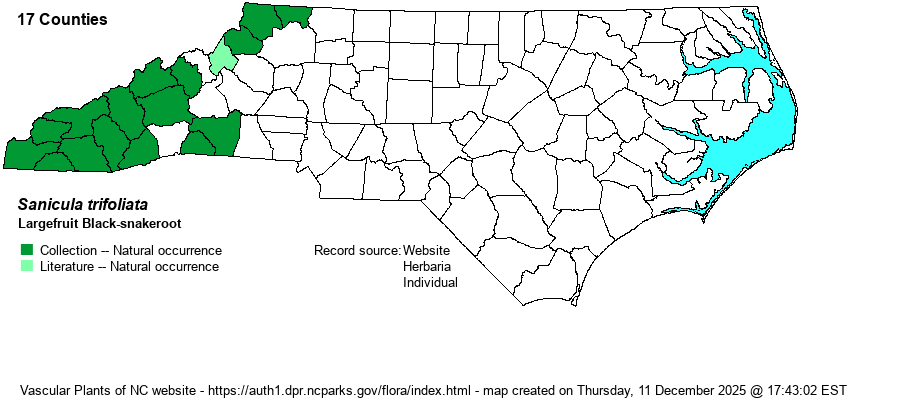| Author | Bicknell | |
| Distribution | A montane species, found essentially throughout the province. Rare in the Piedmont foothills.
This is a rather Northern species, from eastern Canada south to NJ, PA, and IA, and southward mostly in the mountains (and Ohio Valley) to northern GA and central AL.
| |
| Abundance | Uncommon, mainly at middle to higher elevations. | |
| Habitat | This is a species of very rich soil, usually in high pH conditions. It grows in Rich Cove Forests and other forests with similar soils. |
| Phenology | Blooms in May, and fruits in June and July. | |
| Identification | This is a moderate-sized species, growing to 1.5-2 feet tall, generally taller than in other Sanicula species. It has palmately-divided basal and stem leaves. In this species, the leaves are clearly dissected into 3 palmate lobes, and the outer 2 lobes are strongly cleft, though not quite to the midrib. Thus, it has "3 or 5" leaflets, depending on your point of view. Each leaflet is obovate, about 3-4 inches long and about 1.5 inches wide, generally larger than in other species in the genus; as with others, the leaflet margins are strongly serrated. The very small umbels are held high above the leaves on long stalks, and the small petals are white. In this species, the fruit is more ovate to oblong than in others, and larger, often 1/4-inch tall and somewhat narrower. There are a few additional fruit characters, so check Weakley (2018) for additional details. If you are familiar with most of the other, more common Sanicula species, you should note the taller and larger form of this species, and the somewhat more tri-foliate appearance of the stem and basal leaves. | |
| Taxonomic Comments | None
| |
| Other Common Name(s) | Beaked Sanicle, Largefruit Sanicle | |
| State Rank | S3? [S3] | |
| Global Rank | G4 | |
| State Status | | |
| US Status | | |
| USACE-agcp | | |
| USACE-emp | | |

